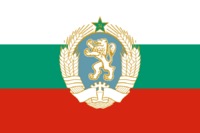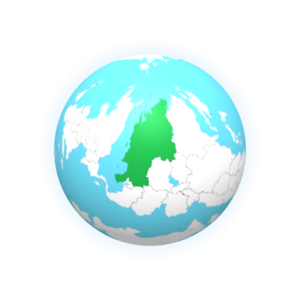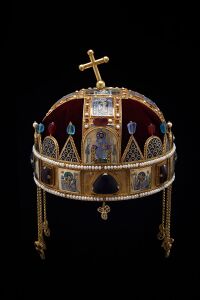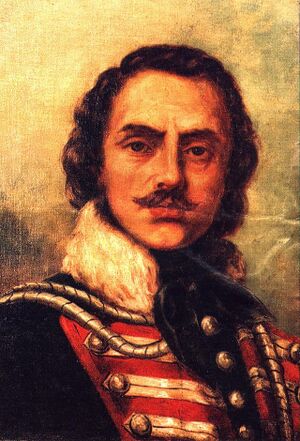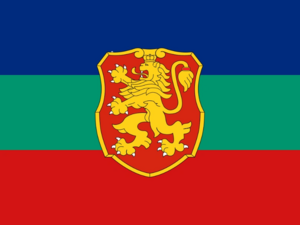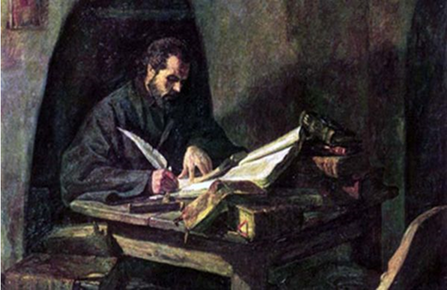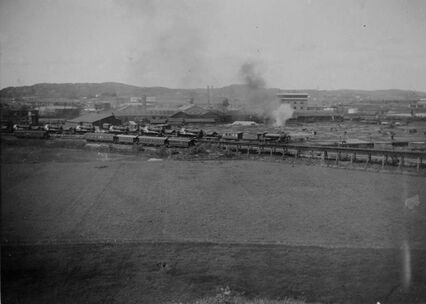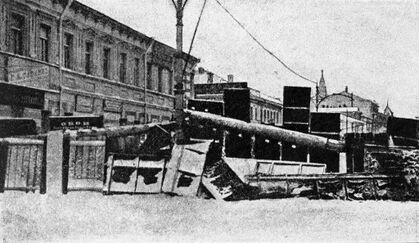United Soviet Socialist Republics of Konzask (Elparia)
United Soviet Socialist Republics of Konzask Обединени съветски социалистически републики Конзаск | |
|---|---|
| Motto: ""Пролетарии по света, обединявайте се!"
(Proletarians of the World, Unite!)" | |
| Anthem: ¡Together, Brothers! | |
| Capital | Safingrad |
| Official languages | Konzaskan |
| Recognised national languages | Konzaskan |
| Recognised regional languages | Konzaskan, Aesidian, Aytuan, Tarazian |
| Religion |
|
| Demonym(s) | Konzaskan |
| Government | Federal Parliamentary Republic |
• President | Velika Filipova |
• Second Secretary | Anton Krasimirov |
| Legislature | Parliament |
| Politburo | |
| Council of Ministers | |
| Foundational History | |
• First Thracian Kingdoms | Crica 15,000 - 500 BCE |
• Foundation of "Great Old Konzask" | Circa 300 AD 632 AD |
• First Konzaskan Empire | Circa 681 - 1018 AD |
• Second Konzaskan Empire | Circa 1185 - 1396 |
• Third Konzaskan Empire | Circa 1400 - February 1st, 1944 |
• United Soviet Socialist Republics of Konzask | February 1st, 1944 - Present Day |
| Population | |
• 2024 estimate | 143, 690, 000 (9th) |
| GDP (PPP) | estimate |
• Total | 04.727 Trillion |
| GDP (nominal) | 2024 estimate |
• Total | $4.727 Trillion (7th) |
• Per capita | $32,897 (24th) |
| HDI (2024) | .870 very high |
| Currency | Konzaskan Lev (лв) (KS) |
| Time zone | UTC+5 to +8 (Safingrad-Corlu-Standard Time\SCMT, Konzask Central Selaria Time\KCSST, Ob'Tel'Sedar Time\OTST) |
| Date format | dd/mm/yy |
| Driving side | left |
| Calling code | +359 |
| Internet TLD | .kk |
The United Soviet Socialist Republics of Konzask (USSRK; Konzaskan: Обединени съветски социалистически републики от Конзаск (ОCCPK) Obedineni sŭvet·ski sotsialisticheski republiki ot Konzask (OSSRK)) is the official name of Konzask. Konzask is a Savinist Penchevist, Federal, Parliamentary Democracy, and has been since 1944, ruled by the Konzaskan Communist Party (KCP). The Konzaskan resistance movement during the Lorraine War deposed the Third Konzaskan Empire's administration in the Konzaskan coup d'état of 1944 which ended the country's alliance with Corusconia and led to the foundation of modern Konzask.
The USSRK modelled its policies after that of Savinist Penchevism ideology, transforming the country over the course of decades from an agrarian peasant society into a heavily industrialized, socialist society. In the mid-1950s and after the death of Mladenov Penchev (the first leader of the USSRK), The USSRK further plunged itself into industrialization, becoming a notable military power, even completing their own successful nuclear project in 1956. Varying degrees of conservative or liberal influence followed,. After new energy and transportation infrastructure was constructed, by 1960 the tech industry became the dominant sector of the economy and Konzask became a major exporter of household goods and later on computer technologies, earning it the nickname of "Silicon Valley of the East". The country's relatively high productivity levels and high scores on social development rankings made it a model for other socialist countries' administrative policies.
Now Konzask is a dominant, communist major power, with a functioning nuclear arsenal, strong industry, great infrastructure and much more. Citizen support of the current "Filipova" Administration, and extent the Communist Party is at it's highest since the 1950's. Konzaskan citizens benefit from free healthcare and education, as well as extensive welfare programs, with the current administration only growing stronger after a string of multiple foreign policy victories in the growing Cold War.
Etymology
The name Konzask is derived from the Konzars, a tribe of eastern origin that founded the country. Their name is not completely understood and is difficult to trace back earlier than the 4th century AD, but it is possibly derived from the eastern word Konģhar ("to mix", "shake", "stir") and its derivative Konlak ("revolt", "disorder"). The meaning may be further extended to "rebel", "incite" or "produce a state of disorder", and so, in the derivative, the "disturbers". Ethnic groups in the inner regions with phonologically similar names were frequently described in similar terms: during the 4th century, the Koluoji, a component of the "Five Barbarian" groups in Ancient Konzask, were portrayed as both a "mixed race" and "troublemakers".
History
Prehistory
Neanderthal remains dating to around 150,000 years ago, or the Middle Paleolithic, are some of the earliest traces of human activity in the lands of modern Konzask. Remains from Homo sapiens found there are dated ca. 47,000 years BP. This result represents the earliest arrival of modern humans in Konzask. The Karanovo culture arose circa 6,500 BC and was one of several Neolithic societies in the region that thrived on agriculture. The Copper Age Varin culture (fifth millennium BC) is credited with inventing gold metallurgy in Osho. The associated Varin Necropolis treasure contains some of the oldest golden jewelry in the world with an approximate age of over 6,000 years. The treasure has been valuable for understanding social hierarchy and stratification in the earliest Kronzask societies.
The Thracians, one of the three primary ancestral groups of modern Konzankans, appeared on the Konkzanksan Peninsula some time before the 12th century BC. The Thracians excelled in metallurgy, but remained tribal and stateless. The ancient Konzar tribes conquered most of present-day Konzask in the 6th century BC and retained control over the region until 479 BC. The invasion became a catalyst for Thracian unity, and the bulk of their tribes united under King Teres to form the Safin Kingdom in the 470s BC, the namesake of Konzask's capital city, Safingrad. It was weakened and vassalized by Stephen II in 341 BC, attacked by tribes in the 3rd century, and finally became enveloped by the Konzar tribes in AD 45.
By the end of the 1st century AD, Konzar governance was established over all of modern Konzask, and surrounding nations and Christianity began spreading in the region around the 4th century. The Gothic Bible—the first Konzaskan language book—was created by Gothic bishop Theodris in what is today northern Konzask around 381. The region started to centralize into a recognizable state after the fall of the early Konzar Khans in 476. This enabled the Slavs to further interbreed with the local Thracian population, primarily through an area between the Bozhure River and the Konzask Mountains known as Mosia. Gradually, much of the coast interior of modern Konzask became a country of Southern Slavs, as Konzar and Thracian cultures and language merged over time, unified under decentralized tribal confederacy, commonly referred to as "Great Old Konzask", under a Khaganate.
First Konzaskan Empire
Not long after the Slavic incursion, Mosia was once again ignited by warfare, this time by civil war, as the Khans each began to centralize power amongst themselves. After a brief period of conflict, "Great Old Konzask" was united under Khan Ermanaric. Their specific horde originated from the territories of the old Safin Kingdom, north of the Ladoga Sea in what is now Valpovar. Ermanaric would soon expand outwards, invading territories that now encompasses modern Novavostok, Gori, Aytua, Taraz, Bursa, Aralia and Bamhkash in 680. A peace treaty with Novavostok was signed in 681, marking the foundation of the First Konzask Empire.
Succeeding rulers strengthened the Konzask state throughout the 8th and 9th centuries. Tsar Krella introduced a written code of law and checked a major Eastern incursion at the Battle of Grova, in which the Novavostok King was killed. Naso I abolished paganism in favor of Eastern Orthodox Christianity in 864. The conversion was followed by an Novavostok recognition of the Konzaskan church and the creation of the Cyrillic alphabet, developed in the then capital, Pishtip. The common language, religion and script strengthened central authority and gradually fused the Thracians and Konzars into a unified people speaking a single Slavic language. A golden age began during the 34-year rule of Emil the Great, who oversaw the largest territorial expansion of the state. Emils rule was instrumental in ensuring the longevity of the Konzaskan state.
After Emil's death, Konzask was weakened by wars with Magyars and Pecheia tribal regions and the spread of the Bogomil heresy. Pishtip was seized by the Novavostok in 971 after consecutive invasions. The Empire briefly recovered from the attacks under Sasho, but this ended when Novavostok defeated the Konzaskan army at Giodoara in 1014. Sasho died shortly after the battle, and by 1018 the Empire would collapse into succession crisis, the realm fragmenting into multiple successor states.
Second Konzaskan Empire
The ensuing succession wars would engulf the realm of the First Konzaskan Empire, and would equally lead to the foundations for many modern states, such as Bamkhash, Bursa, as well as the Gori Merchant families, who would subsequently form the Gori Merchant Republic in 1397 . In 1185 however, Tinchev dynasty nobles Ivan Tinchev I and Sreten IV organized a major uprising and succeeded in re-establishing the Konzaskan state. Ivan Tinchev and Sreten laid the foundations of the Second Konzask Empire with its capital at Tarnovin.
Nedyalko, the third of the Tinchev monarchs, extended his dominion to Belzod and Ohrin. He acknowledged the spiritual supremacy of the pope and received a royal crown from a papal legate. The empire reached its zenith under Ivan Tinchev II (1218–1241), when its borders expanded as far as the coast of Alsnia (now eastern Konzask), Servika (Now central Konzask) and Anbor (now south Konzask), while commerce and culture flourished. Ivan Tinchev's rule was also marked by a shift away from Imperial in religious matters. It would be under the Tinchev dynasty that saw the beginning of the long standing, ongoing rivalry between the Minachian Empire and the Konzask. While already bitter towards one another, Ivan Tinchev's heir would ultimately light the first sparks of the conflict after the Minachian Empire subdued the ancient Kefelarian Empire, where Emperor Tiberius of Minachia would be forced to parlay with the Konzaskan Empire, with the two states now sharing a land border. While evidence suggests both Empires sought future plans to conquer the other, for one reason or another, both Konzaskan and Minachian Empires believed there were more immedeate, pressing issues, as they mutually regarded their natural border along the center of the Isthmus connecting the continents of Osho and Remus. This single recognition would go onto define politics between the two Empires, states coveting the others territory, neither willing to risk all out war for potential very little gain.
The Tinchev dynasty became extinct in 1257. Internal conflicts and incessant Novavostok and Sijran attacks followed. In 1277, swineherd Ivaylo led a great peasant revolt that expelled the Novavostok from Konzask and briefly made him emperor. He was overthrown in 1280 by the feudal landlords, whose factional conflicts caused the Second Konzaskan Empire to disintegrate into small feudal dominions by the 14th century. These fragmented rump states—two tsardoms at Vidin and Tarnovin and the Despotate of Sonzevac each claimed rightful claim over the Empire, with various other states gaining independence, and seeking to forge a path separate from Konzaskan identity.
Third Konzaskan Empire
Konzaskan Dark Age
After four years of conflict over competing successor states, the Despotate of Sonzevac would officially proclaim the "Third Konzaskan Empire" during the edict of Plevena, where Despot Vladislav Ivailov would be coronated as Tsar in 1400 AD. However, due to decades of extensive conflict, many records were lost during the 14th century, making it one of the least documented points in Konzaskan history. While accurate information on the wider Elparian "Dark Ages" is limited, Konzask's is in particular, lending credence to the theory of the sheer brutality of the warring rival successor states at the time. However, family trees from the ruling Ivailov Dynasty from the foundation of the Third Konzaskan Empire, and improved record keeping since it's foundation indicate that the Empire was founded sometime within March of 1400. With what little is known between 1277 AD, and 1400 AD, the Despotates of Vidin and Tarnovin had progressively expanded their territories across modern Konzask, each in an attempt to reclaim the mantle of the Second Empire, with the blood feud between the Kingdoms coming to a head in the later 1300's, engulfing much of modern Konzask in a war that left many of it's regions devastated, and much of the previously, well documented Konzaskan records either gutted, or completely destroyed. Konzasks characteristic, rigorous record keeping practice wouldn't return until the mid 15th Century, well after the solidification of the Ivailov Dynasty, with Dynastic family trees being the only accurate source of information archeologists have uncovered to solidify the exact foundation of the Third Empire.
Early Conquests of the Third Empire
The Rule of the Third Empire, and Ivailov Dynasty brought peace to the war torn Konzask, as well as paved the rise of Absolutism within the once fractured nation, as similarly observed within Remus. After nearly a century of constant conflict, much of the feudal lords and aristocracy had been either greatly diminished, if not completely eradicated, leaving both a significant administrative gap, but also providing the Tsar with a new excessive of direct authority over the realm. The power vacuum was filled by the Tsar directly taking control of administrative and political responsibilities, while filling others by new positions that required the direct appointment of the Tsar themselves, granting the Konzaskan monarchy a level of control that yet had to be seen.
With the void left by the reformation of the Empire leading to rapid centralization, the recently re founded Konzask had an army shaped by centuries of civil war, now with no enemy to be directed towards. Centuries of war, and the subsuming of defeated Despotate and Tsardoms during the Konzaskan Dark Age ensured that in the Empire's early years, it had an army of veterans, and a Monarchy eager to reclaim lost territories, and establish itself once more as a direct rival to the comparatively more stable Minachian Empire. These factors are believed to have motivated the early heads of the Ivailov Dynasty in the reconquest of territories once held by the Second Konzaskan Empire, outside the Konzaskan core regions. The Third Konzaskan Empire would strike first in 1423 in it's conquest of the Gori Merchant Republic to the South, with the goal of seizing the countries expansive ports and drydocks, to serve as the base to create a Konzaskan navy, as the contemporary Minachian Empire began taking to the seas off continent. The Third Empires early conquests would conclude with the Konzaskan expansion into North Central Osho, within modern day Aytuah and Taraz. At the time, the region was dominated by nomadic tribes, and regional Khanates with often fluid borders, as regional powers consistently rose and fell, and more often traded hands between Konzask, Novavostok and Sijran in previous centuries. Tsar Vladislav Ivailov's conquests in North Central Osho would put an end to this trend, establishing firm military rule to the region, coupled with the eventual conquest of Novavostok in later years, and decline of Sijran eradicating Konzask's regional rivals, leaving the territories of modern Aytua and Taraz under Konzaskan direct rule until the Konzaskan revolution in 1944.
The recently conquered regions, unlike within the Konzaskan core, held vastly different cultures and languages to the wider Empire, leading to the creation of regional, autonomous administration, lead by local leaders appointed by the Konzaskan Monarchy, with the regions being titled as "Grand Principalities" (eg The Grand Principality of Gori), allowing for the practice of local culture, and language, as well as limited taxation dictated by local authorities, contributing to the preservation of local cultures into the modern era, as well as preventing ethnic rebellion in the future age of enlightenment in the 18th century.
Invasion of Novavostok
The first major conquest that would go on to establish both the identity, and longevity of the Third Konzaskan Empire was it's invasion, and subsequent conquest of the Novavostok. (June 1st 1453 - February 6th 1460) Historic enemies, Konzask and Novavostok since the earliest recorded documents of their societies depict the consistent conflict shared between the two rival states, with the one often being on the catalyst for the collapse of the other, such as with the Second Konzaskan Empire. Yet, neither had held the capability to fully conquer the other due to their sheer size, both states even in modern era being among the largest states in population, and area in Elparian history. However, with the rise of absolutism, and centralized government, modern administrative practices allowed for the more efficient administration of much larger territories.
All of these factors would reach a boiling point in the early 1440's, shortly after the Konzaskan conquest in North Central Osho. Unlike Konzask, Novavostok was still largely decentralized, and as Konzask had begun slowly eroding Feudal institutions out of necessity, Novavostok still clung to them. While Konzask saw major resurgence in the 15th Century, Novavostok was in the midst of serious stagnation and decline, and the recent acquisition of the once hotly contested region by Konzask, and resurgence of the Konzaskan Empire frightened the neighboring Empire. Resentment only grew as Konzask continued to establish permanent settlements in the region, and expel ethnic Novavostokians from Konzask's northern territories, culminating in Novavostok declaring war in June 1st of 1453, hoping to stunt Konzask's resurgence before it could fully eclipse Novavostok, seeking to take full advantage of the summer weather.
Despite it's intentions, Novavostok still operated under old, feudal mentalities, both in governance, but in warfare as well, with small contingents of professionally trained soldiers, with the bulk of it's military consisting of peasant levies. While this allowed Novavostok a much needed numeric advantage, Konzask, after centuries of war, had a largely professional, organized , veteran armed force, maintaining a large, permanent stationed army. The two vastly different methods of war would be tested on June 15th of 1453 in Osho's far north, in the Konzaskan border region of Rodoi. Not realizing the vast differences between Konzask's military organization and their own, Novavostok believed that Konzask would need a significant amount of time to muster it's forces across it's vast territories, and believed they would do so in the North, as securing the north would have provided Konzask a direct route to Novavostok's capital. Furthermore, as was expected in medieval warfare, Novavostok's commanders believed Konzask would meet them in open pitched battle, where they would overwhelm Konzask with sheer numbers. However, Konzask had an organized, professional standing army nor had any intention of meeting Novavostok in open battle. The most fatal mistake most modern historians recognize in Novavostok's strategy was that they made no effort to conceal their movements, and the failure to adapt to 15th Century warfare, allowing for Konzaskan commanders to identify Novavostok's troop movements, and strategy in the early days of the war, and allowing Konzask to bait Novavostok into a devastating ambush at Rodoi.
Marching in the open, dominated by highly unorganized peasant levies, the Konzaskan army ambushed Novavostok along the coast, leading to a devastating defeat, and the annihilation of Novavostok's offensive capabilities for the remainder of the war. Seeing opportunity, Tsar Stanislav Ivailov (Tsar Circa 1444-1478) launched a full scale invasion of the ailing Empire, leading to a grueling, 7 year long war to occupy the country. By 1460, the Novavostok Imperial family was located, and held captive, as Stanislav Ivailov on February 6th officially announced Konzaskan control of the country. Tsar Stanislav would release the Novavostok Imperial family, and allowed them to maintain their governance over Novavostok, however incorporated into the Third Konzaskan Empire as the Grand Principality of Novavostok, ultimately limiting regional separatism, and ensuring a level of stability in the region until the Novavostok War for Independence in the 19th Century, with the onset of nationalism. The conquest of Novavostok had left Konzask, effectively as the "last Empire standing" on the continent, and would shape Konzask's presence on both Osho, and global politics for centuries to come until the onset of the Enlightenment, and Konzask's eventual renewal during the Industrial Revolution.
Renaissance in Konzask
While originating in Remus, the Renaissance would find it's way to Konzask in the early 16th Century, with the onset of the Protestant Reformation. The Third Konzaskan Empire, much like the Second Empire before it, maintained active contact with Remus, and through it's warm water ports in Gori, Safingrad, and eventually other, newer cities (Smyla, Rusa etc), early Renaissance ideas would eventually make their way to Konzask through trade, and contact with Remusian Merchants. The traditional transport of goods would slowly come with the slow transport of Renaissance, Humanist ideals, which would rapidly begin to take hold in the re-established, and already rapidly reforming Empire. However, perhaps the two most influential events within the Renaissance for Konzask, was the Protestant Reformation, and the discovery of the New World, as these two events would go on to dictate the direction of reform of culture, philosophy and science in the Empire, as well as lay the foundation of colonial ambition in Konzask.
With the Reformation in full swing in Remus amidst the 16th Century, while some nations, such as Arells, embraced Protestantism with open arms, much of the Apostolic world did not, leading to many cases of religious persecution, and often times exile. While many facing religious exile would go on to eventually settle the New World, marginalized groups in smaller number fled to Konzask instead. Konzask, a firmly Orthodox nation, as well as being the founding home of the Orthodox church, Konzask found itself exempt from the extreme religious turmoil that wracked it's neighboring continent. Chiefly among them being that the Empire allowed a measured level of religious tolerance, primarily out of necessity of maintaining stability in a multi-ethnic Empire, with regions worshiping distinctly different religions, especially within North Central Osho. This tolerance, as well as it's relative proximity to Remus made Konzask an simple alternative to the new world for religious exiles. It was through these exiles however that the Renaissance was brought to Konzask in earnest. Exiled groups brought both cultural innovations, but also new technology, such as the printing press. The general level of expression allowed in Konzask allowed early Renaissance art and sculptures to flourish, as well as aided in attracting artists to the Empire. The flourishing of art, and rejuvenation of classical philosophy paved the way for an explosion within Konzaskan culture, and new ideas. It was during this period that cities like Safingrad truly began to boom, and with Safingrad in particular, the Konzaskan Renaissance is when it would be elevated to the states official capital. The Renaissance fundamentally reshaped Konzaskan architecture, in some ways growing analogous to what was seen in Remus, but with the addition of Konzask's unique history, and Konzaskan designs.
The Konzaskan Renaissance, as well as news of the new world is also what would push the Third Empire to transition into a colonial force, eager to cement itself among the internationally recognized Great Powers, and see the rise of Konzaskan funded expeditions, eventually reaching Calderia through the Poseidon Ocean, though would never establish an official overseas colony, the closest Konzask would come to an off continent colony would by the island of Petkovia off the coast of Selaria in the early 1600's. It was these ambitions that would lead Konzask to eventually colonize Zhonghan, and cemented Konzask as a contemporary power amongst it's pears on the world stage.
Colonization of Zhonghan
With Novavostok firmly under Konzaskan control, the only other major player on the continent of Osho was that of the Zhou Dynasty, that ruled over the rough area consisting of modern day Zhonghan. Extremly wealthy, the Zhou Dynasty held a deep, ancient and rich history, and perhaps maintained (and still does maintain) one of the oldest societies in Elparian history. However at the onset of the 17th Century, the Zhou Dynasty was beset by infighting, and deep internal turmoil until it reached a boiling point in 1618, where the once might Empire collapsed inward, dividing itself into various, disparate warlord states.
At the same time, Konzask's colonial ambitions were at their peak, and with Calderia and Salterras being effectively sectioned off, and monopolized by the powers of Remus, and Selaria being logistically impossible to maintain a functioning colony on, as there would be no sea route between Konzask and the continent of Selaria until the Industrial Revolution, the Third Konzaskan Empire was left isolated, and forced to seek out it's colonial ambitions on it's own continent, Osho. It was during this time that the Zhou Dynasty completely collapsed. With the power vacuum now open, Konzask sought to exploit it, due to their now direct land connection to the shattered Empire through Novavostok, where Konzask would strike at the ailing power, siezing significant swaths of territory, as well as Konzaskan owned trade ports along Zhonghans coast, humiliating the collapsing Empire even further.
Zhonghan was not chosen at random, as the region was both extremely resource rich, as well as holding some of the most fertile territory on the continent. While it's sheer size and wealth had let it dominate as it's own regional power, it's internal collapse had spelled opportunity for the expansionist Konzaskan Empire, and the Zhou Dynasties eventual defeat in 1618. Slowly over a period of decades, Konzask would single out, and acquire one of the many Zhou splinter states, bringing it under Konzaskan administration, until eventually by the late 17th century, Konzask had complete control over the entire region.
Unlike in Novavostok, and previous conquests, Konzask didn't attempt to directly integrate Zhonghan into Konzask, nor did they establish a Grand Principality, the ruling Zhou Dynasty being seen as both too unreliable, and unstable to trust ruling Zhonghan under the Konzaskan Empire. Rather, Konzask chose to mimic the west, and would establish a colonial dominion over Zhonghan, leading to the official foundation of the "Dominion of Zhonghan" in 1680. Under Konzaskan rule, Zhonghan was allowed to practice their local religion freely, however, primarily for administration reasons, Dominion curriculum, and power work as taught, and filed in Konzaskan Cyrillic. Taking over a largely illiterate population, after centuries of colonial rule and education, while Zhonghans local languages were preserved, to this day, Zhonghan writes with Cyrillic, creating a unique synthesis of local language, and slavic characters.
Even compared to the relatively autonomous Grand Principalities, the Dominion of Zhonghan was able to function borderline as it's own nation, primarily out of necessity. Konzask was only able to establish it's colonial rule over Zhonghan due to extreme infighting and division, however on it's own, Zhonghan alone, even during the 17th Century had a population that absolutely dwarfed both Konzask, as well as it's Grand Principalities combined. Keenly aware of this, Zhonghan was allowed to be governed by locally elected officials, were allowed to practice their religion, and culture freely, and were offered significantly laxer taxation requirements then Konzask's other subjects. In turn, Zhonghan required significant amount of investment from Konzask, as Konzask spent millions annually for centuries in the modernization of infrastructure and development to ensure regional compliance. In turn, Konzask had ready access to the vast resource and agricultural wealth of Zhonghan, flooding Konzask with exotic foods, spices, and rarer materials unable to mined in Konzask proper. These products would further find themselves on international markets through Konzask, more then making up for the extensive costs required to maintain control over Zhonghan. However this would eventually work against the Third Empire, as the over reliance on Zhonghan colonial imports by the time of the Industrial Revolution would leave rural Konzask heavily neglected, and left to fend for itself in times of drought and famine, which is often cited as a key cause behind the Konzaskan revolution.
The method of colonial rule over Zhonghan would have the unintended side effect of fostering a unique relationship between Konzask and Zhonghan, sharing similar revolutions (as in future centuries, Konzask would often exile it's agitators and revolutionaries to Zhonghan), the amount of freedom and autonomy granted to Zhonghan, development, and a sense of equality that was necessary to maintain dominion over the region helped foster a sense of cultural solidarity between Kozaskans and Zhonghanians, with a level of brotherhood between the two states peoples and governments that often dictates both nations foreign policies to this day. Both Konzask and Zhonghan due to the nature of Konzaskan rule share many holidays, beliefs, cultural traditions, as well as an alphabet, creating a relationship modern historians highlight as analogous to that of Entaria and Trekas, in modern day.
The Enlightenment and Early Modern Konzask
With the birth of the enlightenment in 1685, Konzask was not exempt from the outpouring of new, revolutionary ideas, however handled them much differently then many of their Remusian counter parts. While an absolutist Monarchy to it's core, the Third Konzaskan Empire, up until the Industrial Revolution maintain semi-egalitarian practices, ranging from freedom of religion, limited secular governance, as well as limited rights for minority groups within the Empire (most of which only existed our of necessity, rather then from enlightenment idealism). Conversely, the Ivailov Dynasty maintained strict control over the government, and political proceedings, as ultimately the word of the Tsar was the word of law. However with the arrival of enlightenment ideals in Konzask, the Ivailovs approached it pragmatically, not wanting to provoke discontent, or foment the beginnings of an uprising in the large, multi ethnic Empire Konzask had become. With most hereditary positions having been completely wiped out, and replaced with new, appointed ones, the Ivailovs over the late 17th, and early 18th centuries would appoint increasingly liberal ministers to positions of prominence, as well as experimenting with early liberal economics, such as shifting away from protectionism, and embracing limited forms of free trade. Under this time, the ruling Ivailovs would begin to reshape Konzask's internal structure, reshaping the workings of the Empire to resemble the federal subdivisions of modern Konzask, in turn allowing for more regional representation in government, as well as expanding the government to incorporate representatives from minority groups. It was through these slow, limited reforms that revolution, as seen in the recently independent Treka, and the growth of radicalism in Remus was ultimately avoided within Konzask.
This had the unintended side effect of creating a new literary artistic boom within Konzask. Konzask historically was a nation defined by literary innovation and artistry (such as the invention of the Cyrillic alphabet, and being one of the earliest recorded societies to master gold working), and the increased, limited allowed of free expression, and limited embracement of enlightenment ideals lead to the rise of many new Konzaskan philosophers, thinkers, artists and musicians, which would ultimately go on to shape modern Konzaskan identity, and philosophy. Among these was the historian Paisov of Hildegrad (1722-1773), who would be later canonized as a Saint by the Konzaskan Orthodox Church. He was the first Konzaskan historian in centuries to write a comprehensive, and publicly available national history of Konzask, and was both an avid poet, and champion of representational government.
Other historic Konzaskan figures that rose in prominence during the Konzaskan Enlightenment was Svetla Krichenko, a composer and musician who would go on to fundamentally shape Konzaskan music in the modern era, combining Remusian styled Orchestra, with old, historic Konzaskan folk hymns, further shaping modern Konzaskan identity, and preserving Konzaskan folk traditions and beliefs in the rapidly changing early modern period. One of the most influential figures born at this time was Koylua Fichtov, an architect who's designs would go on to ultimately shape Konzaskan architecture into the Industrial Revolution, and who's influence can be easily identified in many of Konzask's largest cities, with many modern Konzaskan architects attempting to capture the same aesthetic of his designs.
The cultural boom in the Third Konzaskan Empire during the enlightenment is often described as the Empire reaching it's zenith, and peak, by modern historians, as while Konzask would go on to maintain it's status as a Great Power during the industrial revolution, the enlightenment, and birth of modern nationalism would go on to spark the Novavostok War of Independence, which would lead in the backsliding of much of the Konzaskan Empires reforms, and see it spiral deeper into authoritarian practice, and pave the way of it's eventual decline, and overthrowal in the Konzaskan Revolution. The end of the Enlightenment is defined as the end of the Konzaskan Empire for many, as while the Empire would maintain economic, and industrial prominence during the 19th and early 20th Century, the Empire would enter near unreversible political backslide, and near total collapse of it's rural population.
The Industrial Revolution in Konzask
Where the industrial revolution started in Konzask is a topic hotly contested between it's various regions, many of Konzask's most prominent cities wanting to claim it originated within them. However, contemporary historians believe the Konzaskan Industrial Revolution began in Gori in 1835, placing the Konzaskan Industrial Revolution fairly late in Elparian History (The First Industrial Revolution being placed at 1760). Gori being one of the largest trade hubs in Konzask, saw some of Konzask's earliest manufactories take shape in the port city, as Konzask found itself growing increasingly ingrained in the international market, with early manufactories rising in the wake of rapidly increasing international demands. 1835 through 1850 would see similar manufactories begin sprouting up in Konzask across it's crucial trade cities, including the capital of Safingrad. The new manufactories, overtime would grow both in size and complexity, overtime beginning to require new sources of power, which would in turn be achieved with steam. The advent of steam power in Konzaskan manufactories would in turn lead to new transportation methods to transport goods across Konzask's vase land area to it's burgeoning industrial centers, ultimately leading to the first Konzaskan steam locomotives and railways.
New railways, and manufactories in Konzaskan cities would start the beginning of Konzask's rural - urban migration, as farmers would begin migrating to Konzask's growing cities in search of more well paying jobs, which would cycle into the expansion, and construction of new manufactories, which created the need for new railroads, these new railroads leading to the need for new locomotives, and the complexity, and resources required to produce these locomotives would eventually lead to the creation of the first early Konzaskan factories in 1872.
Konzask economically, for much of it's history under the Third Empire had it's economy primarily centered around trade and through resource extraction. It's location, and warm water ports in northern Osho singled it out as one of the regions most influential, and only trade centers, with many of the continents warm water powers being dominated by the colonies of off continent Empires, while Konzask itself, and with the addition of colonial Zhonghan within it's Empire, made it both exceptionally resource rich, but left it with the ability to profit off of it's resources on a global scale. It would be these facts that would shape Konzask's industrial revolution.
Being a large land Empire, much of Konzask's resource rich regions were far apart from one another, and in order to both use these resources domestically, and export them internationally, traditional methods of transport became increasingly ineffective, which shaped the prominence of the Konzaskan railway during the Industrial Revolution, with much of Konzask's early domestic industry centered around steel making for the railroad, and for the production of early steam locomotives. With the prominence of trade within the Konzaskan economy, early manufactories were founded late into the first industrial revolution to better produce simple goods in large quantities. However, these early manufactories would hastily evolve into Konzask's first factories during the Second Industrial Revolution in the wake of new innovations, and growth of the Konzaskan rail network.
As the country grew more interconnected by rail, much of Konzask's rural population would begin to migrate to Konzask's cities in search of higher paying work, while Konzaskan mining towns also grew in size, both due to new innovations, such as dynamite and rail, but also due to migration, with many seeking to find their fortune within Konzask's resource rich mines. The factors put together lead to Konzask industrializing at a similar pace to it's Remus and Calderran counterparts, and allowing it to remain both a competitive, and recognized power. However, this rapid industrialization came with many unintended consequences, and would be one of the leading factors to the Konzaskan Revolution.
Decline of Rural Konzask and Political Decline
While rural migration was a natural consequence of industrialization in any nation, it was particularly devastating for Konzask. Historically a vary rural country, Konzask until the 1700's had few, but large urban centers, many of which hundreds, if not thousands of years old, while the majority of the population was spread out across the large country. The Konzaskan countryside before the industrialization, and up until the mid 20th century made up the majority of Konzask's population, and with the onset of both industrialization, the Konzaskan government had begun heavily pushing sweeping urbanization campaigns, with many seeking out urban life organically, while in other instances, peasants would begin to leave their farms in order to attempt to take up mining, in hopes of becoming wealthy off of Konzask's booming mining industry, and eventually oil industry in the later half of the 19th century.
Konzaskan rural settlements would slowly grow abandoned, and farms either undermanned, and unmaintained, leading to both progressively declining harvests, but also causing long term environmental damage to the land and soil due to poor maintenance. With quality of the soil declining, committed farmers were forced to migrate to either more fertile land, often completely uncompensated, or move to the growing Konzaskan cities, equally with no support, or education, leading to soaring level of poverty, and increased pressure on the peasants that remained in the countryside, which still did make up the majority of the empire. With Konzask continuing to push it's export economy, and assert itself on the global market, rather then supporting rural needs, Konzask only increased demands and quotas. Konzaskan rural populations were put under further pressure as Konzask continuing to import, and sell vast quantities of Zhonghan grown agricultural products, making it near impossible for Konzaskan farmers to compete in local markets, and making it increasingly difficult to support themselves. These factors would inevitably lead to famine in the 20th Century, and would become one of the catalysts for Revolution.
It was during this period where the philosophies of Demetrius Savinus (1857-1901) would begin to spread in Konzask. Quality of life for rural Konzask rapidly declined, mixed with next to no safety regulation in Konzask's growing mining settlements, and with increased food prices in Konzask's cities, and deteriorating living conditions due to the Industrial drive ultimately served to undo the progressive balance of power between the Monarchy, and revolutionary ideals seen during the Enlightenment. Growing discontent would see the Tsar sack many of the countries liberal ministers, and crack down on the historically lax laws around political and cultural expression as open discontent grew. It was during this time that many of Konzask's political thinkers were driven underground, and the growing Konzaskan working class grew increasingly radicalized, due to deteriorating quality of life, and growing government crack down in the wake of increasingly common food shortages. Figures like Hilestro Boletchev would rise in prominence in this period as political agitators, as rather then pushing for increased representation in government, began to call for an end to the monarchy all together. However, liberal ideals failed to take route in Konzask, in part due to the Monarchys association with liberal policies, as well as many associating food shortages with liberal policy, as much of the food that would have been kept in Konzask was being shipped abroad, and lack of government intervention to prevent rising food prices, and deteriorating wages.
It would lead to prominent political thinkers like Hilestro Boletchev, who found themselves enraptured by the revolutionary, and early communist philosophies espoused by Demetrius Savinus, to begin smuggling Savinus's works, such as "The Communist Manifesto", "Das Kapital", among other political essays and pamphlets into Konzask, using their influence within Konzaskan media to include these pamphlets in Konzaskan papers, and illegally distributed within Konzaskan libraries. Boletchev in particular is seen as a national hero, as he would be the first to combine Savinist philosophy, with Konzaskan beliefs, and regional Konzaskan political realities. A revolutionary firebrand, Boletchev was among the first to organize Konzask's political underground, his charisma, and educated background attracting both academics, as well as the Konzaskan working class. His unique philosophy, and works such as "My Prayer", and "At Farwell", combining Savinist working class philosophy, as well as the needs, and prominence of the rural Konzaskan that lead to early socialist beliefs to spread across the Empire like wildfire, as well as what lead to his arrest, and execution. Boletchev's political organization after his death, would eventually form into the Fatherland Front, a broad coalition of anti-monarchist political groups, both Socialist and Liberal, but primarily dominated by differing views of Savinism, pioneered by the Konzaskan working and rural classes, that would ultimately responsible for overthrowing the Monarchy in 1944. It was also these views, and failure of the Konzaskan government to attend to rural needs that would foster Novavostok nationalism, and lead to Novavostoks war of Independence in the 1890's, and lead to the eventual collapse of the Konzaskan Empire in the 20th Century. It's also identified as a key factor behind Zhonghans revolution, as fearing mass unrest from executing political dissidents, Konzask would begin exiling political radicals to Zhonghan, to keep them out of Konzask, but only serving to create a Savinist underground within it's colony.
Novavostok War of Independence (1886-1890)
With the political backslide facing the Third Konzaskan Empire, and spread of revolutionary ideals, and most importantly, the sharp rise of early modern nationalism would ultimately prove to be the death nail for Konzaskan rule over Novavostok. While order was able to be maintained due to a level of autonomy, freedom to express and celebrate local culture, and permitting the Novavostok Imperial family to rule over the then Grand Principality of Novavostok. However, as representation declined, and as the issues plaguing it's own rural population spread to Novavostok, while reaping a fraction of the benefit, as radicalism spread in the Konzaskan political underground, it did in Novavostok as well. Being a Grand Principality, while Novavostok was directly under the Konzaskan flag, it has a level of autonomy, including the freedom to arm itself, and as nationalism took hold in Novavostok, and conditions both continued to deteriorate, and Konzask continued to neglect the region in favor of Zhonghan, especially with the discovery of oil within the colony, seizing the opportunity, the Novavostok Imperial family would officially declare independence, leading to a brutal, and bloody four year long war.
